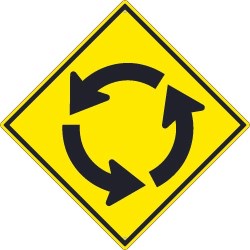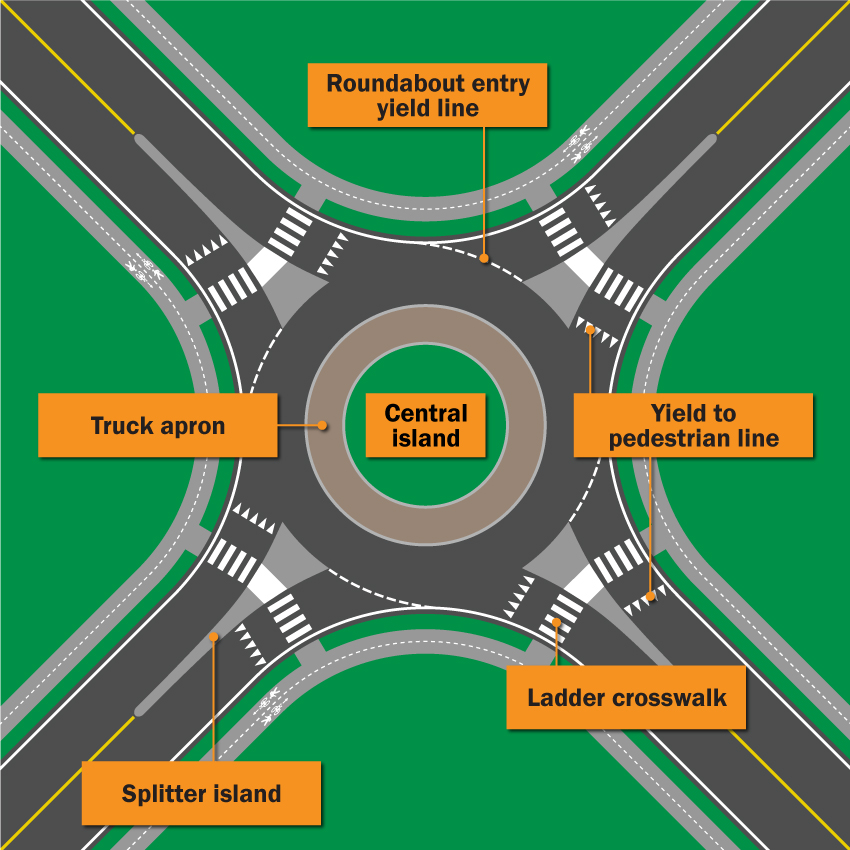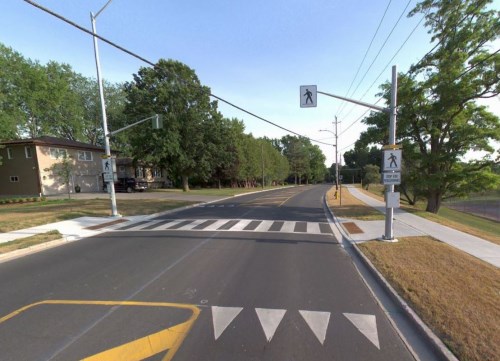| Type of sign | What it means | Image of sign |
| One-way |
|
 |
| Chevron |
|
 |
| Pedestrian crossover sign |
|
 |
| Roundabout warning |
|
 |
Roundabouts
Roundabouts in Peterborough
The City of Peterborough has opened its first major roundabout, located at the intersection of Parkhill Road West, Brealey Drive and Ackison Road. These circular intersections are an alternative to the traditional traffic signal intersection design. Roundabouts can improve road safety, manage increased traffic demand, and help improve air quality by eliminating unnecessary stops and vehicle idling.
What are roundabouts?
A roundabout is a circular intersection where two or more roads meet. Traffic circulates through the roundabout in a counter-clockwise direction, to the right of a central island. All entering vehicles must yield to traffic already in the roundabout, as well as pedestrians or cyclists where there is a signed Pedestrian Crossover.
Drivers
Entering the roundabout
- Always slow down when approaching a roundabout.
- Stop for any pedestrians or cyclists using a signed Pedestrian Crossover.
- Yield to any traffic or cyclists currently in the roundabout, and stop if needed.
- Proceed only when there is a safe gap in traffic.
Within the roundabout
- Always drive counter-clockwise in a roundabout.
- Drive slowly and be alert for entering traffic.
- Never pass another vehicle or stop within a roundabout.
- Remember that all entering traffic is required to yield to you.
Exiting the roundabout
- Always signal right as you exit the roundabout.
- Stop at the yield to pedestrian line for any pedestrians or cyclists at a signed Pedestrian Crossover.
Cyclists
Cyclists typically have two options at a roundabout depending on their degree of comfort riding in traffic:
Experienced cyclists
- Ride as if you were driving a car.
- Merge from the bike lane into the vehicular travel lane before entering the roundabout.
- Ride in the middle of the lane while in the roundabout; do not hug the curb.
- Use hand signals to indicate when you are exiting the roundabout.
Less confident cyclists
- The shared pathway and Pedestrian Crossover provides an alternative crossing option for cyclists who would be more comfortable navigating the roundabout as a pedestrian rather than as a vehicle.
- Use the off-ramps located in advance of the roundabout to access the shared pathway.
- Dismount and walk your bicycle at the signed Pedestrian Crossover.
Pedestrians
- Pedestrians must cross at signed Pedestrian Crossover locations and should never use the central island.
- Wait at the curb, indicating you want to cross.
- Look and listen for a safe gap in traffic flow.
- Do not cross until the driver stops; drivers are legally required to stop at a signed Pedestrian Crossover.
- Keep and make eye contact with drivers in all lanes, use your finger to point as your cross.
- Stop and wait on the splitter island and ensure there is a safe gap in traffic on the other side of the splitter island. Repeat the process above when crossing from the splitter island.
Additional tips for pedestrians
- Drivers are more likely to yield if your body language shows you intend to cross.
- Enter the crosswalk briskly and deliberately once you have confirmed the drivers have stopped.
Signs and pavement markings

Roundabout entry yield line
- A series of square pavement markings separating the approach lane and the roundabout lane.
- Vehicles should stop behind this line while waiting for a safe gap in traffic.
Central island
- The raised space in the center of the roundabout.
- The central island always contains directional signage and often contains landscaping and low-lying vegetation.
Truck apron
- The truck apron is the outer part of the central island.
- It is mountable and intended to be used by large trucks, buses, oversized vehicles, and emergency vehicles to safely traverse the roundabout.
Splitter island
- The splitter island separates the entry and exit lanes of a roundabout.
- The splitter island also provides a safe refuge for pedestrians crossing at the signed Pedestrian Crossovers.
- Pedestrians are expected to stop on the splitter island to make sure the way is clear before proceeding.
Ladder crosswalk
- This type of crosswalk is required at Pedestrian Crossover locations for increased visibility.
- Pedestrians crossing at a roundabout must do so where there are ladder crosswalks.
- The figure to the right shows a typical Pedestrian Crossover layout including ladder crosswalks and yield to pedestrian lines.
Yield to pedestrian line
- These triangular pavement markings indicate the location drivers are required to stop while waiting for pedestrians to cross at the signed Pedestrian Crossover.
- Drivers will see these lines at both the entrance and exit of the roundabout.
- Ladder crosswalks and yield to pedestrian lines are required features of a pedestrian crossover.
Frequently asked questions
What are the benefits of roundabouts
- Reduces the speed of vehicles entering the intersection.
- Reduces the number of vehicle and pedestrian conflicts compared to a traditional signalized intersection.
- The collisions and injuries experienced at roundabouts are typically less severe compared to signalized intersections.
What do I do if an emergency vehicle comes through the roundabout?
- If you have not entered the roundabout, pull to the right and let the emergency vehicle pass you.
- If you are in the roundabout, exit as soon as safely possible and proceed beyond the splitter islands before pulling over to allow room for the emergency vehicle to pass by.
- Never stop within the roundabout.
Will Peterborough see more roundabouts in the future?
- Roundabouts are expected to be considered in future development and major road reconstruction.
- Smaller neighborhood roundabouts are already built or planned for new subdivisions on the Official Plan, including:
- Chemong Secondary Land Use Plan
- Lily Lake Secondary Land Use Plan
Where can I learn more about roundabouts in Ontario?
Contact Us
City Hall
500 George St. N.
Peterborough, ON
K9H 3R9
Phone: 705-742-7777
Toll Free: 1-855-738-3755
Email Us


